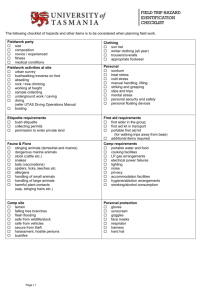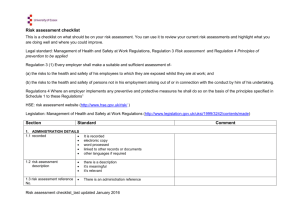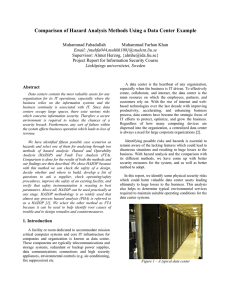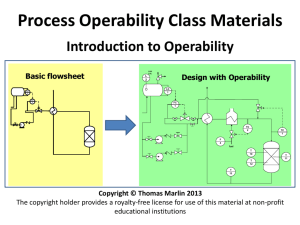Document
advertisement
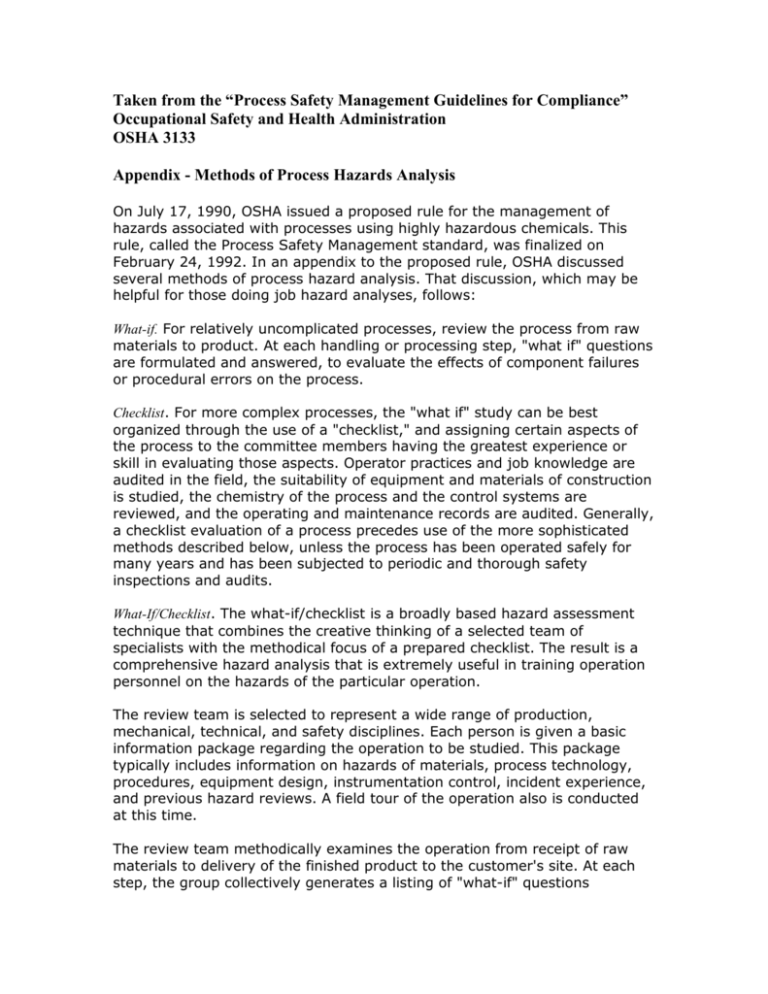
Taken from the “Process Safety Management Guidelines for Compliance” Occupational Safety and Health Administration OSHA 3133 Appendix - Methods of Process Hazards Analysis On July 17, 1990, OSHA issued a proposed rule for the management of hazards associated with processes using highly hazardous chemicals. This rule, called the Process Safety Management standard, was finalized on February 24, 1992. In an appendix to the proposed rule, OSHA discussed several methods of process hazard analysis. That discussion, which may be helpful for those doing job hazard analyses, follows: What-if. For relatively uncomplicated processes, review the process from raw materials to product. At each handling or processing step, "what if" questions are formulated and answered, to evaluate the effects of component failures or procedural errors on the process. Checklist. For more complex processes, the "what if" study can be best organized through the use of a "checklist," and assigning certain aspects of the process to the committee members having the greatest experience or skill in evaluating those aspects. Operator practices and job knowledge are audited in the field, the suitability of equipment and materials of construction is studied, the chemistry of the process and the control systems are reviewed, and the operating and maintenance records are audited. Generally, a checklist evaluation of a process precedes use of the more sophisticated methods described below, unless the process has been operated safely for many years and has been subjected to periodic and thorough safety inspections and audits. What-If/Checklist. The what-if/checklist is a broadly based hazard assessment technique that combines the creative thinking of a selected team of specialists with the methodical focus of a prepared checklist. The result is a comprehensive hazard analysis that is extremely useful in training operation personnel on the hazards of the particular operation. The review team is selected to represent a wide range of production, mechanical, technical, and safety disciplines. Each person is given a basic information package regarding the operation to be studied. This package typically includes information on hazards of materials, process technology, procedures, equipment design, instrumentation control, incident experience, and previous hazard reviews. A field tour of the operation also is conducted at this time. The review team methodically examines the operation from receipt of raw materials to delivery of the finished product to the customer's site. At each step, the group collectively generates a listing of "what-if" questions regarding the hazards and safety of the operation. When the review team has completed listing its spontaneously generated questions, it systematically goes through a prepared checklist to stimulate additional questions. Subsequently, answers are developed for each question. The review team then works to achieve a consensus on each question and answer. From these answers, a listing of recommendations is developed specifying the need for additional action or study. The recommendations, along with the list of questions and answers, become the key elements of the hazard assessment report. Hazard and Operability Study (HAZOP). HAZOP is a formally structured method of systematically investigating each element of a system for all of the ways in which important parameters can deviate from the intended design conditions to create hazards and operability problems. The hazard and operability problems are typically determined by a study of the piping and instrument diagrams (or plant model) by a team of personnel who critically analyze effects of potential problems arising in each pipeline and each vessel of the operation. Pertinent parameters are selected, for example, flow, temperature, pressure, and time. Then the effect of deviations from design conditions of each parameter is examined. A list of key words, for example, "more of," "less of," "part of," are selected for use in describing each potential deviation. The system is evaluated as designed and with deviations noted. All causes of failure are identified. Existing safeguards and protection are identified. An assessment is made weighing the consequences, causes, and protection requirements involved. Failure Mode and Effect Analysis (FMEA). The FMEA is a methodical study of component failures. This review starts with a diagram of the operation, and includes all components that could fail and conceivably affect the safety of the operation. Typical examples are instrument transmitters, controllers, valves, pumps, rotometers, etc. These components are listed on a data tabulation sheet and individually analyzed for the following: ▪ Potential mode of failure, (i.e., open, closed, on, off, leaks, etc); ▪ Consequence of the failure; effect on other components and effects on whole system; ▪ Hazard class, (i.e., high, moderate, low); ▪ Probability of failure; ▪ Detection methods; and ▪ Remarks/compensating provisions. Multiple concurrent failures are also included in the analysis. The last step in the analysis is to analyze the data for each component or multiple component failure and develop a series of recommendations appropriate to risk management. Fault Tree Analysis. A fault tree analysis can be either a qualitative or a quantitative model of all the undesirable outcomes, such as a toxic gas release or explosion, that could result from a specific initiating event. It begins with a graphic representation (using logic symbols) of all possible sequences of events that could result in an incident. The resulting diagram looks like a tree with many branches listing the sequential events (failures) for different independent paths to the top event. Probabilities (using failure rate data) are assigned to each event and then used to calculate the probability of occurrence of the undesired event. This technique is particularly useful in evaluating the effect of alternative actions on reducing the probability of occurrence of the undesired event.


